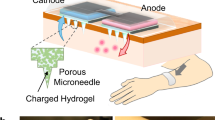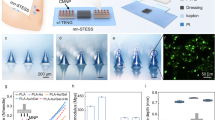Abstract
Therapeutic uses of compounds produced by biotechnology are presently limited by the lack of non-invasive methods for continuous administration of biologically-active macromolecules. Transdermal delivery would be an attractive solution, except macromolecules have not previously been delivered clinically across human skin at therapeutic rates. To increase transport of a highly-charged macromolecule (heparin), high-voltage pulses believed to cause electroporation were applied to skin. Using this approach, transdermal heparin transport across human skin in vitro occurred at therapeutic rates (100–500 μg/cm2h), reported to be sufficient for systemic anticoagulation. In contrast, fluxes caused by low-voltage iontophoresis having the same time-averaged current were an order of magnitude lower. Heparin transported across the skin was biologically active, but with only one eighth the anticoagulant activity of heparin in the donor compartment due to preferential transport of small (less active) heparin molecules. Flux, activity, and transport number data together suggest that high-voltage pulsing creates transient changes in skin microstructure which do not occur during iontophoresis. Safety issues are discussed.
This is a preview of subscription content, access via your institution
Access options
Subscribe to this journal
Receive 12 print issues and online access
$209.00 per year
only $17.42 per issue
Buy this article
- Purchase on Springer Link
- Instant access to full article PDF
Prices may be subject to local taxes which are calculated during checkout
Similar content being viewed by others
References
Schwendeman, S.P., Cardamone, M., Brandon, M.R., Klibanov, A. and Langer, R. 1995. Stability of proteins and their delivery from biodegradable polymer microspheres. In: Cohen, S. and Bernstein, H. (Eds.). Microspheres/Microparticulates—Characterization and Pharmaceutical Applications, in press. Marcel Dekker, NY.
Bronaugh, R.L. and Maibach, H.I. 1989. Percutaneous Absorption, Mechanisms—Methodology—Drug Delivery. Marcel Dekker, New York.
Hadgraft, J. and Guy, R.H. 1989. Transdennal Drug Dehvery: Developmental Issues and Research Initiatives. Marcel Dekker, NY.
Smith, E.W. and Maibach, H.I. 1995. Percutaneous Penetration Enhancers. CRC Press, Boca Raton, FL.
Prausnitz, M.R., Bose, V.G., Langer, R. and Weaver, J.C. 1992. Transdermal drug delivery by electroporation. Proceed. Intern. Symp. Control. Rel. Bioact. Mater. 19: 232–233.
Prausnitz, M.R., Bose, V.G., Langer, R. and Weaver, J.C. 1993. Electroporation of mammalian skin: a mechanism to enhance transdermal drug delivery. Proc. Natl. Acad. Sci. USA 90: 10504–10508.
Bommannan, D., Tamada, J., Leung, L. and Potts, R.O. 1994. Effect of electroporation on transdermal iontophoretic delivery of luteinizing hormone releasing hormone (LHRH) in vitro. Pharm. Res. 11: 1809–1814.
Prausnitz, M.R., Pliquett, U., Langer, R. and Weaver, J.C. 1994. Rapid temporal control of transdermal drug delivery by electroporation. Pharm. Res. 11: 1834–1837.
Vanbever, R., Lecouturier, N. and Préat, V. 1994. Transdermal delivery of metoprolol by electroporation. Pharm. Res. 11: 1657–1662.
Prausnitz, M.R., Bose, V.G., Langer, R. and Weaver, J.C. 1995. Electroporation, p. 393–405. In: Percutaneous Penetration Enhancers. Smith, E.W. and Maibach, H.I. (Eds.). CRC Press, Boca Raton, FL.
Pliquett, U., Langer, R. and Weaver, J.C. 1995. The change in the passive electrical properties of human stratum corneum due to electroporation. Biochim. Biophys. Acta. In press.
Pliquett, U. and Weaver, J.C. 1995. Transport of a charged molecule across the human epidermis due to electroporation. J. Controlled Release. In press.
Pliquett, U. and Weaver, J.C. 1995. Electroporation of human skin: simultaneous measurement of changes in the transport of two fluorescent molecules and in the passive electrical properties. Bioelectrochem. Bioenerget. In press.
Pliquett, U., Zewart, T.E., Chen, T., Langer, R. and Weaver, J.C. 1995. Imaging of fluorescent molecule and small ion transport through human stratum corneum during high voltage pulsing: localized transport regions are involved. Biophys. Chem. In press.
Prausnitz, M.R., Lee, C.S., Liu, C.H., Pang, J.G., Singh, T.-R., Langer, R. and Weaver, J.C. 1995. Transdennal transport efficiency during skin electroporation and iontophoresis. J. Controlled Release. In press.
Chizmadzhev, Y.A., Zarnytsin, V.G., Weaver, J.C. and Potts, R.O. 1995. Mechanism of electroinduced ionic species transport through a multilamellar lipid system. Biophys. J. 68: 749–765.
Edwards, D.A., Prausnitz, M.R., Langer, R. and Weaver, J.C. Analysis of enhanced transdermal transport by skin electroporation. J. Controlled Release 34: 211–221.
Neumann, E., Sowers, A.E. and Jordan, C.A. 1989. Electroporation and Electrofusion in Cell Biology. Plenum Press, NY.
Tsong, T.Y. 1991. Electroporation of cell membranes. Biophys. J. 60: 297–306.
Chang, D.C., Chassy, B.M., Saunders, J.A. and Sowers, A.E. 1992. Guide to Electroporation and Electrofusion. Academic Press, NY.
Orlowski, S. and Mir, L.M. 1993. Cell electropermeabilization: a new tool for biochemical and pharmacological studies. Biochim. Biophys. Acta 1154: 51–63.
Weaver, J.C. 1993. Electroporation: a general phenomenon for manipulating cells and tissues. J. Cell. Biochem. 51: 426–435.
Majerus, P.W., Broze, G.I., Miletech, J.P. and Tollefsen, D.M. 1990. Anticoagulant, throtnbolytic, and antiplatelet drugs, p. 1311–1334. In: The Pharmacological Basis of Therapeutics. Gilman, A. G., Rail, T. W., Nies, A. S. and Taylor, P. (Eds.). Pergamon Press, New York.
Theroux, P., Waters, D., Lam, J., Juneau, M. and McCans, H. 1992. Reactivation of unstable angina after discontinuation of heparin. N. Engl. J. Med. 327: 141–145.
Edelman, E.R., Adams, D.H. and Karnovsky, M.J. 1990. Effect of controlled adventitial heparin delivery on smooth muscle cell proliferation following endothelial injury. Proc. Natl. Acad. Sci. USA 87: 3773–3777.
Ledger, P.W. 1992. Skin biological issues in electrically enhanced transdennal delivery. Adv. Drug Deliv. Rev. 9: 289–307.
Tojo, K., Chiang, C.C., Doshi, U. and Chien, Y.W. 1988. Stratum corneum reservior capacity affecting dynamics of transdermal drug delivery. Drug Dev. & Ind. Pharm. 14: 561–572.
Klenchin, V.A., Sukharev, S.I., Serov, S.M., Chemomordik, L.V. and Chizmadzhev, Y.A. 1991. Electrically induced DNA uptake by cells is a fast process involving DNA electrophoresis. Biophys. J. 60: 804–811.
Lane, D.A., Bjork, I. and Lindahl, U. 1992. Heparin and Related Polysaccharides. Plenum Press, NY.
Bockris, J.O. and Reddy, A.K.N. 1970. Modern Electrochemistry. Plenum, NY.
Webster, J.G. 1988. Encyclopedia of Medical Devices and Instrumentation. Wiley & Sons, NY.
Gummer, C.L. 1989. The in vitro evaluation of transdennal delivery, p. 177–186. In: Transdermal Drug Delivery: Development Issues and Research Initiatives. Hadgraft, J. and Guy, R. H. (Eds.). Marcel Dekker, NY.
Freed, L.E., Vunjak-Norakovic, G.V., Drinker, P.A. and Langer, R. 1993. Bioreactor based on suspended particles of immobilized enzyme. Ann. Biomed. Eng. 21: 57–65.
Bose, V.G. 1994. Electrical Characterization of Electroporation of Human Stratum Corneum. MS Thesis, Massachusetts Institute of Technology, Cambridge, MA.
Oliver, J.D., Anderson, S., Troy, J.L., Brenner, B.M. and Deen, W.M. 1992. Determination of glomerular size—selectivity in the normal rate with ficoll. J. Am. Soc. Nephrol. 3: 214–228.
Budavari, S. 1989. The Merck Index. Merck & Co., Rahway, NJ.
Atkins, P.W. 1986. Physical Chemistry. W. H. Freeman and Co., NY.
Author information
Authors and Affiliations
Rights and permissions
About this article
Cite this article
Prausnitz, M., Edelman, E., Gimm, J. et al. Transdermal Delivery of Heparin by Skin Electroporation. Nat Biotechnol 13, 1205–1209 (1995). https://doi.org/10.1038/nbt1195-1205
Received:
Accepted:
Issue Date:
DOI: https://doi.org/10.1038/nbt1195-1205
This article is cited by
-
Recent advances in transdermal drug delivery
Archives of Pharmacal Research (2010)



